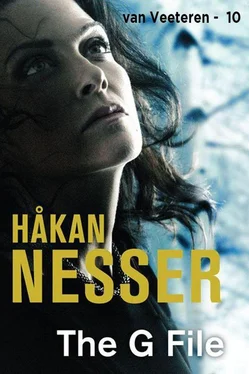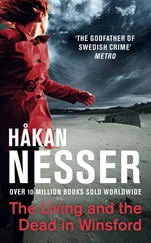Hakan Nesser - The G File
Здесь есть возможность читать онлайн «Hakan Nesser - The G File» весь текст электронной книги совершенно бесплатно (целиком полную версию без сокращений). В некоторых случаях можно слушать аудио, скачать через торрент в формате fb2 и присутствует краткое содержание. Год выпуска: 2014, ISBN: 2014, Издательство: Mantle, Жанр: Полицейский детектив, на английском языке. Описание произведения, (предисловие) а так же отзывы посетителей доступны на портале библиотеки ЛибКат.
- Название:The G File
- Автор:
- Издательство:Mantle
- Жанр:
- Год:2014
- ISBN:9780230766303
- Рейтинг книги:5 / 5. Голосов: 1
-
Избранное:Добавить в избранное
- Отзывы:
-
Ваша оценка:
- 100
- 1
- 2
- 3
- 4
- 5
The G File: краткое содержание, описание и аннотация
Предлагаем к чтению аннотацию, описание, краткое содержание или предисловие (зависит от того, что написал сам автор книги «The G File»). Если вы не нашли необходимую информацию о книге — напишите в комментариях, мы постараемся отыскать её.
The G File — читать онлайн бесплатно полную книгу (весь текст) целиком
Ниже представлен текст книги, разбитый по страницам. Система сохранения места последней прочитанной страницы, позволяет с удобством читать онлайн бесплатно книгу «The G File», без необходимости каждый раз заново искать на чём Вы остановились. Поставьте закладку, и сможете в любой момент перейти на страницу, на которой закончили чтение.
Интервал:
Закладка:
What had he said to Münster? Something about a restful weekend?
He hadn’t even had time to glance at the chess problem in the Allgemejne .
But at half past eleven he flopped down at last in the armchair with Pergolesi ringing in his ears. Dark in the room. Renate in bed, Erich in bed. The disc was fifty-eight minutes long — he had checked that before switching it on. It also contained the Orpheus cantatas.
Good, he thought. At last an hour of high-quality life.
And at last an opportunity to think about his relationship with G.
What could be a better-quality accompaniment to that than the Dolorosa duet, sung by Julia Gouda and Anna Faulkner? He took three deep breaths and floated back thirty-five years in time. That was where it was — his strongest memory of G.
Blacker than black.
Autumn term at Manneringskolan on the banks of Poostlenergraacht, to be more exact. Age: early puberty. Main characters: G, VV and a little Jewish boy by the name of Adam Bronstein.
G: the big, strong and feared young man. Adam Bronstein: the gifted, spectacles-wearing, quick-thinking, anaemic one. VV: the hesitant one who didn’t dare to pick a fight with G, didn’t dare intervene and put a stop to the bullying of those weaker than himself. It is not only Adam Bronstein who suffers, but he is the main victim.
The terrible deed takes place after a PE class. When the teacher (the immensely unpopular herr Schwaager) has left — and when most of the boys have finished the necessary washing and clothes-changing and left the gym that smells strongly of sweat (located in an old wooden building between the school itself and the canal) — G forces Adam Bronstein to lie down on the large grey mat that is used for practising somersaults and similar useful exercises. The skinny little boy does as he is told and G rolls him up inside the mat. It becomes a large, compact cylinder, just over a metre high and just over a metre in diameter. A leather strap fastened around it prevents it from unrolling. Thanks to his own considerable strength and the assistance of one of the boys still left (his name is Claus Fendermann and he is destined to become an outstanding pianist), G stands the cylinder upright — with Adam Bronstein’s head at the bottom. His arms are pressed closely against his sides, his feet in a pair of pitiful blue-grey socks with worn-out elastic tops sticking a few centimetres out of the top. The boy is stuck there in a sort of dark, iron-hard vice: his head is slowly filled with blood, it becomes increasingly difficult for him to breathe — and the boys leave him there in that state. G, Claus Fendermann, VV and several others. They gather together their things and hurry off to their conventional classroom. G is the last to leave, and closes the door behind him.
There is no class in the gymnasium the following period, so Adam Bronstein stays inside the cylinder for almost an hour. It is a cleaner who finds him. He is still alive, but only just. He spends two months in hospital. Never comes back to school.
The news breaks in January that he has hanged himself.
It is not usual for thirteen-year-olds to hang themselves. Not at that time, at least.
He might just as well have died straight off in the bloody mat, says G. The little Jewish swine.
Stabat mater .
The Quis est homo movement began, and Van Veeteren realized that he was sweating profusely in his armchair. Cold sweat. Adam Bronstein was only one of the memories associated with G. There were more. But perhaps that one was sufficient to be going on with?
He tried to concentrate on Friday’s confrontation instead.
What had it signified? In fact?
Why had he chosen that absurdly hard-boiled line during the conversation at Villa Zefyr? Silence and polished steel. Why? There was no doubt that he had overdone Borkmann’s rule of silence.
And why had he been so convinced of Hennan’s guilt when he spoke to Münster about it afterwards in the car? The inspector had sounded sceptical, and rightly so.
Did he really think that G had got rid of his wife? Killed her? Hand on heart.
Wasn’t it rather a sudden urge — and a sudden opportunity out of the blue — to give G what he deserved? To put things to rights and punish him thirty-five years later? Once and for all.
Was it really as simple as that?
In any case, it was difficult to ignore these private motives for revenge — but maybe it was good that he had allowed himself to wallow in them? From the very start. Motives that you didn’t recognize were more difficult to cope with than those you dragged up to the surface, he was aware of that. It was something even Borkmann had pointed out on one occasion or another — although in that case it had to do with the motivation of a criminal rather than that of a police officer investigating a case.
But if he could now — in theory at least — ignore the deep-seated disgust he felt for Jaan G. Hennan, push it to one side for a moment, what were the facts of the circumstances surrounding Hennan’s wife’s death?
Was there any real reason to suspect a crime?
And if there was, was there any objective justification for directing those suspicions at G?
Van Veeteren closed his eyes and tried to relax. The questions were pointless. They were being asked too early. Of the traditional puzzle-pieces Motive-Method-Opportunity, only the second was anywhere close to being identified. If in fact it was the case that Barbara Hennan had been murdered, there was not much doubt about the method. The way in which it had been carried out. A push in the back — or as much violence as could be considered necessary to make her lose her balance and fall down from the diving tower.
Another matter, of course, was getting her up there in the first place. That would probably not have been due to brute strength. Cunning, more likely. . Presumably some kind of very subtle cunning.
Or perhaps she had been knocked unconscious by a blow to the head? It would have been difficult to carry her up the steps to the top of the diving tower afterwards, but no doubt not impossible. He made a mental note to ask Meusse if one might be able to distinguish between a wound that had been inflicted slightly earlier than — and in a different way to — those that were the result of her crashing down into the bottom of the empty swimming pool.
That was more or less all that could be said about the method, Van Veeteren thought. He wondered if he ought to go and fetch a beer from the kitchen, but decided against it.
What about Opportunity? Well, it wasn’t especially difficult to speculate about that.
Anybody at all who might have been in the vicinity of Villa Zefyr at about ten o’clock on Thursday evening would have had an opportunity — hypothetically at least — to carry out the murder in the way spelled out above. The problem was that the most interesting figure in this context — Jaan G. Hennan — appeared to have an alibi for this time.
Appeared . Obviously, it remained to be seen how solid this alibi really was. Sachs and his team ought surely to have had enough time to sort out this matter by now.
That left Motive. Who had had any reason to kill Barbara Hennan? And more specifically: what motives might G have had?
Van Veeteren decided that if there was one question he ought to examine rather more closely in the next few days, it was this one.
If there is even a fraction of a possibility that he is behind this, the Chief Inspector thought, gritting his teeth. . If G has anything at all to do with the death of his wife, I shall put him behind bars for it. For Adam Bronstein’s sake and all the other poor devils he has tortured in one way or another during his life.
It was quite simply his duty. An absolutely imperative duty.
Читать дальшеИнтервал:
Закладка:
Похожие книги на «The G File»
Представляем Вашему вниманию похожие книги на «The G File» списком для выбора. Мы отобрали схожую по названию и смыслу литературу в надежде предоставить читателям больше вариантов отыскать новые, интересные, ещё непрочитанные произведения.
Обсуждение, отзывы о книге «The G File» и просто собственные мнения читателей. Оставьте ваши комментарии, напишите, что Вы думаете о произведении, его смысле или главных героях. Укажите что конкретно понравилось, а что нет, и почему Вы так считаете.












